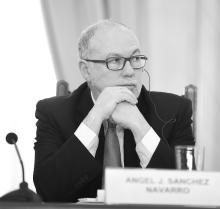
The D'Hondt Method and the scapegoat theory (full article)
A well-known economist, prominent in the media, often points out that "a man's best friend is not his dog but a scapegoat." A statement that, most assuredly, is perfectly applicable to the oft-cited, but little known, D'Hondt Method.
1. To explain that statement, one must start by recalling what the D'Hondt Method (or “law” as it is termed in Spanish) is. The latter, despite being generally referred to as such, is not a “law” in the classic juridical sense that constrains behaviour by permitting, prohibiting or compelling people to do or refrain from doing something. In fact, it is something quite different: a formula or mathematical law named after its creator, the Belgian jurist, politician and mathematician Victor D'Hondt, who formulated it over 140 years ago, in 1878. Shortly thereafter, in 1882, this multifaceted Catholic developed the foundations of this electoral formula in the sparse 70 pages of its practical and reasoned system of proportional representation (Système pratique et raisonné de représentation proportionnelle, Brussels, Librairie C. Muquardt).
This mathematical formula became law, in the strict legal sense of the term, when the Spanish legislature adopted it in order to implement the mathematical principle of proportionality in solving the practical problem of allocating parliamentary seats. And, like any mathematical formula, it operates on the basis of data, which in this case constitute the politically central data in a democratic system: the number and distribution of votes issued by citizens in favour of any of the candidates participating in a given electoral process. If, as García de Enterría said at the time, the jurist's main task is to turn metaphysics into a technical method, the D'Hondt electoral formula is the technical rule chosen by the legislator to implement in practice the democratic principle that converts popular votes (the expression of the democratic will of the people, the only sovereign from which all the powers of the state emanate according to Article 1.2 of the Spanish Constitution) in parliamentary seats.
Technically, the D'Hondt formula is merely a formula whereby the seats at play have to be allocated to the various candidates in proportion to the votes they each obtain, which is why it is a proportional formula. It thus differs radically from majority-based approaches, which allocate the seats in play to the candidates that obtain a larger number of votes. Proportional approaches are intended to facilitate access to Parliament for the various political forces, be they in the majority or minority, which obtain some social support. They seek to include social pluralism in the Chambers, even at the risk of parliamentary fragmentation that makes it difficult to form parliamentary majorities and, secondly, a government. Majority-based systems, on the other hand, facilitate these parliamentary and therefore governmental majorities, even at the cost of excluding from Parliament minority political forces even though they may be socially significant.
It is a fact that, among the most commonly used proportional methods, the D'Hondt method is one of the many variants (among others, Sainte-Lague, Imperiali, and Hagenbasch-Bischoff) of the formula called "of the highest average", whose objective is "that the average cost in votes... [of] a seat is markedly the same for each party." For this reason "it tends to favour parties or lists of candidates with the highest number of votes and disadvantages minorities."[1] In contrast to this "family" is the formula "of the largest decrease" (which in turn has other variants: Hare, Droop, Reinforced Imperiali, Hare-Andrae or Single Transferable Vote) is "in principle more favourable to a distribution of seats that reflects... the distribution of votes among candidates", although it is true that such variants "are often accompanied by other provisions that attenuate its proportionalising effect", in particular minimum electoral barriers to access the Chambers[2].
2. In 19th century Belgium, D'Hondt was seeking to ensure a fair distribution of the seats among social and political forces in the country at the time: Catholics and liberals, belonging to different linguistic communities. Likewise, the Spanish legislation drafted during the transition aimed to ensure access to Parliament, more specifically to the Congress of Deputies, of most of the political formations with a certain degree of social support.
This was the objective of the Law for Political Reform (LRP, Law 1/1977, of 4 January), which provided that Congressional Deputies would be "elected by universal, direct and secret suffrage of Spaniards of legal age" for the first time since the Second Republic, drawing inspiration "on proportional representation criteria" (Article 2 and First Transitional Provision). This "inclusive" orientation intrinsic to proportional methods was immediately nuanced because the same Provision entrusted the Government with the regulating of "the first elections to the Cortes to constitute a Congress of 350 Deputies" modulating the initial proportional orientation according to "the following bases:
First. Corrective provisions shall be applied to prevent inappropriate fragmentation of the Chamber, for which the minimum percentages of votes shall be set to win a seat in Congress.
Second. The constituency shall be the province, setting an initial minimum number of Deputies for each of them."[3]
And it was precisely the rule drawn up by the Government in the exercise of this enactment (the Legislative Royal Decree 20/1977) that incorporated this mathematical method into Spanish electoral law. According to point IV of its Preamble "the distribution of seats shall be carried out in accordance with the 'D'Hondt’ rule, which consolidates in a single operation the operation of the electoral quotient and the calculation of remainders according to the highest mean average system." However, it went on to say that "this same rule already constitutes a powerful corrective measure of the excessive fragmenting of parliamentary representations", adding that "fit is for this very purpose that those lists of candidates that fail to obtain at least three per cent of the votes cast in the constituency are excluded from the allocation of seats." In this way, the instruction contained in the LRP was altered by emphasising first of all the "corrective effect" of the method, relegating to a secondary consideration the electoral barrier that in the LRP clearly appeared as the main measure in order to avoid "inappropriate fragmentations."
In any case, the term "D'Hondt rule" disappears after the electoral law was enacted, is not used again in Article 20 (which describes the system for the election of Deputies) nor in the current electoral law (Organic Law 5/1985, of June 19, on the General Electoral Rules: LOREG), Article 163 of which contains the same system even by replicating, as an example, a table identical to that of the 1977 rules.
3. More than four decades after this rule became part of Spanish electoral law, the data confirm that the purpose of achieving an "inclusive" Congress of Deputies has to a large extent been achieved. Thus, in the last elections held on 10 November 2019, 19 parties or coalitions entered Congress, a significant increase from those that achieved it in April of the same year, June 2016, December 2015 or November 2011. In fact, in the last four elections (2015-2019) the party with the most votes that did not win a seat was the Animal Rights Party (PACMA), which polled at around 1% (0.94 on 10 November 2019; 1.25 in April; 1.19 in June 2016, 0.87 in December 2015)[4]. After this party, only political forces with minimal support (less than 0.4%) were left without a seat in the lower Chamber.
4. Based on these data, one should reduce the criticisms of the "D'Hondt law" that are frequently made of the defects of our electoral system to their fair extent.
Indeed, it has often been blamed for the obvious disproportion between the popular votes cast in elections and the distribution of seats in the Congress of Deputies. However, it is now generally accepted that such a deviation is largely due to the small size of the constituencies in which that law applies, and the minimum initial number of representatives provided for each of them. Aspects that were both already present in the 1977 rule, even if they were not presented as "corrective devices" of parliamentary fragmentation. In fact, the frequent simulations that have been done in various fields to find out the possible effect on the Spanish model of other proportional electoral methods (replacing the D'Hondt method with some other variant) have shown that as long as the two previously mentioned aspects are maintained, the overall results do not change significantly.
For many years it has been repeated that the D'Hondt method was the main cause of the predominant two-party system in much of the democratic period begun in 1977. However, as the facts have confirmed, this two-party system was actually essentially due to the fact that citizens during many legislatures have mostly cast their votes for two main parties nationally. It was due to changes in citizens' preferences, and the electoral method remaining unchanged, that the two-party system disappeared.
With the same logic, it has been blamed for the prominent role played by nationalist parties: it is claimed that this "law" is what makes such parties skew the balance defining parliamentary majorities, ignoring once again that this position is due to the popular votes and not the mathematical formula. A mere reading of the electoral data confirms, to paraphrase the law of conservation of energy, that the D'Hondt method transforms nationalist votes into nationalist seats, but it neither creates nor destroys non-nationalists.
Indeed, as can be seen in the table below, the percentages of congressional seats jointly achieved by nationalist, regionalist and localist movements are not usually far removed, at least not excessively, from their electoral percentages.
|
Date of the elections |
Votes (%) |
% Seats (%, number) |
|
November 2019 |
12.04 |
12.28 (43) |
|
April 2019 |
8.91 |
10 (35) |
|
June 2016 |
6.93 |
7.1 (25) |
|
November 2011 |
10.37 |
10.9 (38) |
|
March 2008 |
7.13 |
6.86 (24) |
In other words, since the electorate of these parties is concentrated in a few constituencies (in each case; although they as a whole they cover a large part of Spain[5]) and tend to compete among themselves, their results are quite in line with their electoral strength (they are therefore quite proportional). And this is the case in politically different contexts, both in the "multiparty" political period that began in 2014-2015 and in the previous essentially bipartisan one.
In any case, to illustrate the baselessness of such criticisms of this method, which is attributed with capabilities it does not have, the fact that it has spread peacefully to all the other elections held in Spain according to proportional criteria: the European Parliament elections (art. 216 LOREG), regional elections (according to the respective Statutes of Autonomy and electoral laws) and in the vast majority of municipal elections (art. 180 LOREG). To put it another way, in almost all of the elections held in Spain (with the sole exceptions of the Senate elections and municipal ones in the smaller municipalities, arts. 166 and 184 LOREG), the D’Hondt method is the one chosen to distribute the seats in play. In this way, it appears as an essential element of the Spanish electoral system at all levels that has operated normally without major problems, apart from sporadic and irrelevant debates in specific cases generally explained by the specific interests at stake, which are unavoidable in any type of contest, electoral or otherwise.
5. In short, the raison d'être of the D'Hondt method is its intrinsic usefulness as a method of distributing seats among political forces that participate in an electoral process, with limited and very well-known effects. But, unfortunately, its wide popularity seems to be largely due to the fact that it has served as a scapegoat, to which to attribute many election results that have not met previous expectations, without the need to provide a justification and therefore at no cost. The best ally to explain election results without an in-depth analysis of the specific functioning of the electoral system, and the multiple elements that comprise it.
[1] VALLÉS, J. Mª. & BOSCH, A.: Sistemas electorales y gobierno representativo. Barcelona, Ariel, 1997, p. 89. However, this effect that acts in favour of the major parties may not be so evident depending on the context: for example, supporters of this system in the United Kingdom stress that - of course, the majority system currently in force - would favour small parties (a useful explanation of how the D'Hondt system operates can be found at https://www.youtube.com/watch?v=6CU3F3ToIIg).
[2] See VALLÉS, J. Mª. and BOSCH, A., op. cit., pp. 89-99. A more recent study of the various proportional representation systems, with several examples of their practical application, can be found in PÁ-MONEO, M.; MARK GARROTE, Ma. and PANO PUEY, E.: Derecho electoral español. Curitiba, Juruá Ed., 2018, where the two categories cited are referred to, respectively, as "quotient formulas" and "divisor formulas" (pages 139-143.)
[3] The italics here as well as the subsequent citations from legal texts, have been logically added.
[4] All of the data used in these pages come from the website of the Ministry of the Interior (http://www.infoelectoral.mir.es/; last accessed: 29 November 2019).
[5] They include Navarra Suma, but not En Comú Podem. As a whole, they have run in at least 19 provinces, achieving representation in many of them (but not all).










Add comment